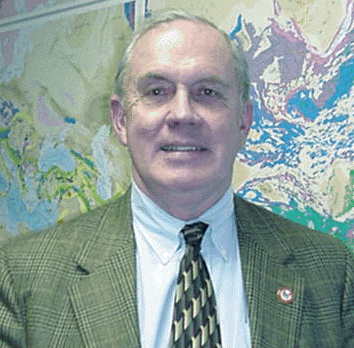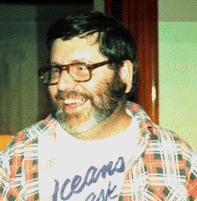
 |
|
|
| AGI Member Society News
Obituary |
  |
A comprehensive listing of news and announcements from the American Geological Institute's 35 member societies.
The Geological Society of America (GSA) announces 1999 award
winners, application procedures for 2000 awards and new officers for 2000:
Grant A. Meyer of Middlebury College, Vt.,
was awarded the 1999 Gladys W. Cole Memorial Research Award for
his project on postglacial climate and alluvial system processes in Wyoming.
The award provides an $11,000 stipend for research on geomorphology of
semiarid and arid terrains in the United States and Mexico.
T. Markham Puckett of the University of Alabama
won the 1999 W. Storrs Cole Memorial Research Award for work on ostracodes
in sequence stratigraphy. The award provides a $9,000 stipend for research
in micropaleontology.
Applications for this year’s Gladys W. Cole and W. Storrs Cole Memorial
Research Awards are due Feb. 1, 2000. The awards will be given to GSA members
or fellows between the ages of 30 and 65. Applicants must have published
one or more significant papers in the field of geomorphology for the Gladys
W. Cole award or in the field of micropaleontology for the W. Storrs Cole
award. Contact: The Research Grants Administrator, Geological Society of
America, P.O. Box 9140, Boulder, Colo. 80301.E-mail: lcarter@geosociety.org.
WWW: www.geosociety.org.
At its annual meeting in Denver last October, the
GSA elected the following new officers for 1999–2000: President Mary Lou
Zoback, U.S. Geological Survey, Menlo Park, Calif.; Vice-President Sharon
Mosher, University of Texas at Austin; and Past President Gail M. Ashley
of Rutgers University. David E. Dunn continues as treasurer. Of the 12
councilors for GSA, four are newly elected. They are: Rena M. Bonem of
Baylor University in Waco, Texas; Mary P. Anderson of the University of
Wisconsin-Madison; Harry Y. (Hap) McSween Jr. of the University of Tennessee;
and Barbara J. Tewksbury of Hamilton College in Clinton, N.Y.
This year the GSA expands its global partnerships
to include the Geological Society of London.
The Mineralogical Society of America (MSA) announced its award
winners, grant recipients and officers for 2000:
Robert C. Reynolds Jr. of Dartmouth College is the society’s 2000 Roebling
Medalist. The 2000 Mid-Career Award recipient was George R. Rossman of
the California Institute of Technology. Quenton C. Williams of the
University of California at Santa Cruz received the 2000 MSA Award.
The 2000 recipient for the research grant in crystallography
from the Edward H. Kraus Crystallographic Research Fund is Mikala S.
Beig of Rice University, recognized for his study of “Silicate crystallography,
weathering and the greenhouse effect.”
Julia Ann Baldwin of the Massachusetts Institute
of Technology and Cin-Ty Aelous Lee of Harvard University are this
year’s recipients for research grants in mineralogy and petrology from
MSA’s Mineralogy/Petrology Research Fund. Baldwin won for her study on
monazite paragenesis in the Striding-Athabasca mylonite zone in northern
Saskatcghewan, Canada. Lee is studying the evolution of the continental
lithosphere.
The Mineralogical Society of America’s newly elected
officers beginning terms in 2000 include: President William Carlson
(2000)
of the University of Texas at Austin; Vice President Cornelis Klein
(2000) of the University of New Mexico and Secretary David M. Jenkins
(2000–2001) of the State University of New York, Binghamton. The new councilors
(2000–2002) are: David L. Bish of the Los Alamos National Laboratory
and Jeffrey E. Post of the Smithsonian Institution, Washington,
D.C. The past president is John M. Ferry and Brooks Hanson
continues as treasurer. Mark S. Ghiorso, Robert W. Luth,
Michael
A. Carpenter and Sorena S. Sorensen continue as councilors.

|
The American Geological Institute (AGI) begins 2000 with President Russell G. Slayback of Leggette, Brashears & Graham Inc. Slayback first served on the executive committee as a member-at-large in 1995—since then AGI has expanded to include nine more member societies. “This year we need to concentrate on showing member societies their value for their participation in AGI,” he says. Advancing the progress of the environmental awareness series and linking the government affairs program to Earth Science Week so the two “develop a synergy together” are also parts of Slayback’s vision for AGI. |
After serving two years as treasurer (1989-1991) and then as a member of the AGI Finance Committee, Larry D. Woodfork of the West Virginia Geological Survey is again serving on AGI’s executive committee—this time as president-elect. Woodfork is a distinguished geologist and petroleum engineer, named “West Virginia Oil and Gas Man of the Year” in 1991. Woodfork received the highest award from the Eastern Section, American Association of Petroleum Geologists in 1996: the John T. Galey Memorial Medal.
L. Stanley Pittman of Petroleum Logistics Corp. in Dallas, Texas, starts his first year as treasurer for AGI. An exploration geologist for more than 40 years, Pittman has delved a variety of areas, including the Rocky Mountains, the Greater Appalachian basin and the Pearl River Basin in China.
Member-at-large Rhea L. Graham starts her first term. Graham returned to New Mexico after serving as the director of the U.S. Bureau of Mines from 1994 to 1996. She spends much of her time now as an advocate for science education and curriculum in the public schools. She is also serving her second year as councilor for the Geological Society of America.
AGI’s Past President David A. Stephenson of S.S. Papadopulos & Associates Inc. consults on issues in groundwater and water-resource management. He has served clients such as Motorola, Del Monte, Unocal, Bank of America, and Santa Fe Pacific Pipeline. He has also provided expert testimony on soil and groundwater contamination.
Joanne V. Lerud, director of the Arthur Lakes Library of the Colorado School of Mines, continues her second year as secretary. Lerud served on AGI’s GeoRef Advisory Committee from 1993 to 1995. She is also a past president of the Geoscience Information Society.
Suzanne O’Connell, associate professor in the Department of Earth and Environmental Sciences at Wesleyan University in Middletown, Conn., continues as member-at-large. A frequent guest lecturer, O’Connell has served as a visiting professor at Massachusetts Institute of Technology.
Lawrence P. Wilding, of Texas A&M University, continues his
second year as member-at-large. Wilding is a fellow of the American Association
for the Advancement of Science and a member of the U.S. National Committee
on Soil Science.
Bruce S. Appelbaum, vice president of Texaco Exploration, continues
as chair of the AGI Foundation. Appelbaum also serves on the Board of Directors
of Child Advocates, Spindletop International and the Houston Museum of
Natural Science. He is also on the advisory board of the School of Earth
Sciences at Stanford University.
The Society Page is compiled by Christina Reed, associate editor of Geotimes.
| James V. O’Connor, 55, a District of Columbia geologist who
used the city streets as his classroom, died Nov. 5 at his home in Kingston,
Md. He had esophageal cancer.
O’Connor was born in the Boston area and graduated from Boston College, where he also received a master’s degree in teaching. He moved to the Washington area in 1970 for further study at the University of Maryland, where he taught before joining the U.S. Geological Survey in 1972. He taught geology at the University of the District of Columbia (UDC) for 21 years until 1997, when university cutbacks left him and many other professors without jobs. |

James V. O'Connor. Photo supplied courtesy of the O'Connor family. |
While teaching at UDC, O’Connor served as “state geologist” for the District. He led more than 300 science education workshops with field components that educated children and teachers about their surroundings. He led tours for the Smithsonian Resident Associates and taught classes at the Audubon Naturalist Society and U.S. Department of Agriculture Graduate School. During his classroom adventures, O’Connor would point out fossils found in building stones along with paved-over geophysical features such as a former stream valley in downtown Washington.
O’Connor was president of the D.C. Environmental Education Consortium. He served as past president of both the National Marine Educators Association and the eastern section of the National Association of Geoscience Teachers. He was also on the boards of the Audubon Naturalist Society and Discovery Creek Children’s Museum, and on the editorial board of the Journal of Marine Education.
O’Connor had trained for the Jesuit priesthood before deciding to become a scientist. His true calling, he believed, was to instill in others the same passion he had for the natural world, especially geology.
To continue his legacy, the James Vincent O’Connor Environmental Education Memorial Scholarship Fund will offer grants to educators who would like to take a course or attend a conference or workshop focusing on environmental content or outdoor educational methods. The only requirement is that the course, conference, or workshop contains a field component that takes the participant outdoors.
For more information contact the Audubon Naturalist Society, 8940 Jones
Mill Road, Chevy Chase, Md. 20815.
 |
Geotimes Home | AGI Home | Information Services | Geoscience Education | Public Policy | Programs | Publications | Careers |